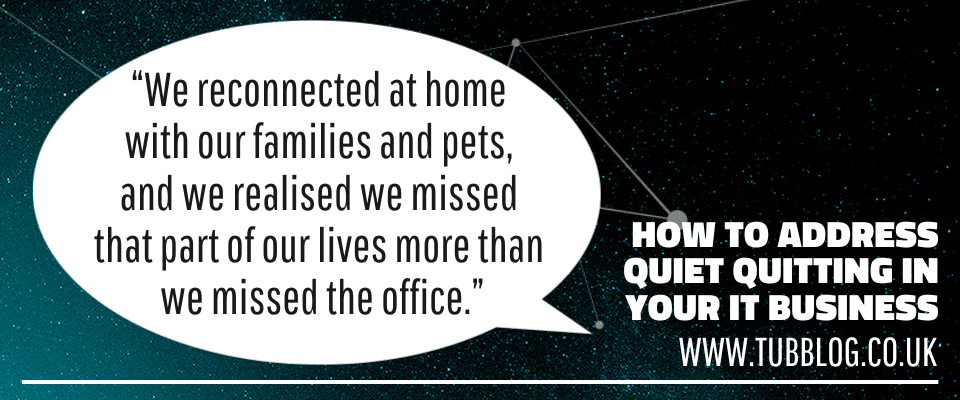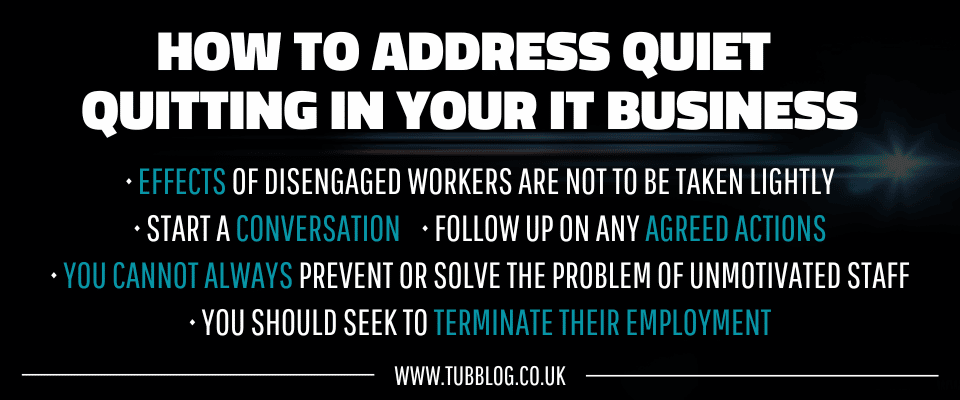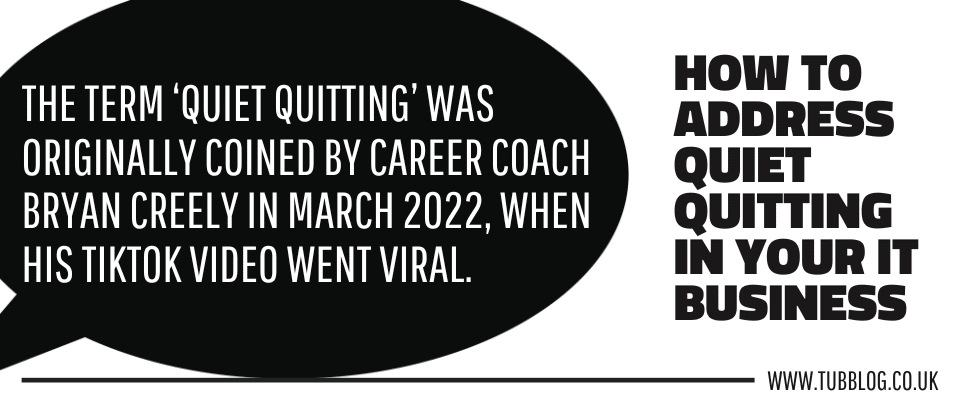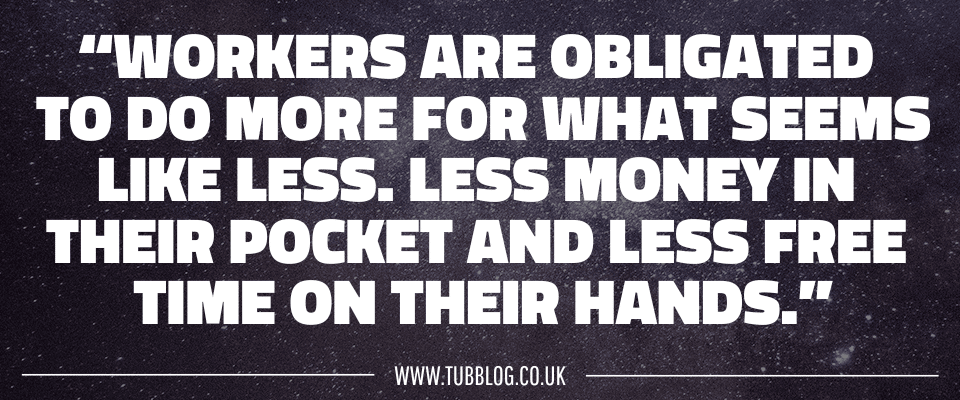The trend of ‘quiet quitting’ is continuing to persist, especially amongst younger employees. Unlike ‘The Great Resignation’, which saw many workers quit their jobs, quiet quitters stick at their jobs, but refuse to do any more than they’re contractually obliged to.
They may feel their remuneration is lacking, or feel their working conditions could be better, but worse than this, they usually always feel disengaged or unappreciated, and that your investment in them as an employer is lacking.
Despite their feelings, their contributions, or lack of, can have a profound effect on your business’s productivity.
So, how can you limit the damage quiet quitting can do to your business?
What is Quiet Quitting?
The term ‘quiet quitting’ was originally coined by career coach Bryan Creely in March 2022, when his TikTok video went viral.
According to Dictionary.com the definition of ‘quiet quitting’ is “an informal term for the practice of reducing the amount of effort one devotes to one’s job, such as by stopping the completion of any tasks not explicitly stated in the job description.”
Essentially, it’s when an employee refuses to go above and beyond their duties, usually when they feel they’re undervalued by their employer, and disengaged as a member of the company.
Similar Expressions
Quiet quitting is a method of expressing dissatisfaction with the working situation, and is linked to similar buzz terms coined in the 2020s.
Those include:
- Anti-Ambition – a shift in attitude for workers to strive for flexible working conditions above promotions and greater responsibility
- Lying Flat – also known as ‘Tang Ping’, a Chinese social movement where a leisurely lifestyle is pursued in favour of professional demands and societal expectations
- The Great Resignation – a widespread trend where a significant number of workers quit their jobs during the COVID-19 pandemic
 Quiet quitting is a trend that followed on from the pandemic’s Great Resignation, but it persists today, in part, due to wage increases being unable to keep up with inflation.
Quiet quitting is a trend that followed on from the pandemic’s Great Resignation, but it persists today, in part, due to wage increases being unable to keep up with inflation.
Although, employees can be perceived to quietly quit for other reasons.
Some argue that people quiet quit to protect their mental health. To avoid the stress and eventual burnout of over-working, but also to set boundaries of control over what is tolerable.
According to research by Gallup last year, quiet quitters make up at least 50% of the US workforce. A poll by recruitment experts Monster Intelligence reported that:
- 60% of workers say they’re being underpaid for what they’re asked to do
- While 61% of workers say they’re feeling burned out
Is Quiet Quitting Still a Problem?
There are plenty of reasons to believe that quiet quitting is in decline. Google Trends show fewer searches for ‘quiet quitting’ in the last quarter, and many believe the buzz around the alliterative trend has begun to wane.
While it might be true that the term is not as popular as it once was, it does not mean that it’s gone away – I’d wager that the term ‘pandemic’ returns fewer searches than it did two years ago.
A number of factors have come into play post-pandemic which affect workers, the most important being:
- Rising inflation and the cost of living
- Flexible working and striving for a better work/life balance
Workers are obligated to do more for what seems like less. Less money in their pocket and less free time on their hands.
Tayo Bero of The Guardian newspaper describes it an ‘act of defiance’ claiming that “…tired, overworked, burnt-out working-class people are taking back their agency and refusing jobs and working conditions that are unsuitable for us.”
There is an argument that the term quiet quitting is just hype for workers standing up for themselves and not taking on additional unpaid work. It’s worth noting that ‘hustle culture’, where employees work extra hard as credit for a future promotion, has been in decline since around the same time quiet quitting became a trend.
Whatever the name for it, and whatever the case, it’s clear that the problem is something for an employer to address directly with the workers involved, and on a one-to-one basis. Engagement and direct communication are key – it’s not something that will often repair itself.
The Dangers of Disengaged Employees
We are going to make the assumption that quiet quitting is similar to employee disengagement.
The problems caused by employees who are not actively engaged have a detrimental effect on your business.
- Productivity and quality of work suffer – output is both slow and sloppy
- Minimal contributions to collaborative projects – can cause delays to projects while not contributing their expert knowledge where it’s needed
- Their attitude reflects badly on your business – both in terms of brand and culture. Nobody likes poor service from an unhappy employee
- They desire to work elsewhere – despite your investment in them, they’ll be looking to move on
- Their negative attitude can disrupt other workers – they often complain openly, leading to more unhappy workers
According to Gallup’s State of the Global Workplace 2022 Report, employees who were not engaged, or actively disengaged, cost the world $7.8 trillion in lost productivity.

Steps You Can Take to Mitigate the Problem
In knowing that disengaged employees are quietly costing your business money, it’s down to you to do something about it.
Communication is Key
Listening goes a long way to understanding why there is a problem in the first place.
Hold one-to-one meetings and performance reviews. By highlighting areas for improvement, you can spark engagement, especially if you encourage new and interesting ways for them to get involved.
More inspiring ways of working may increase buy-in from the affected employee.
If they feel remuneration for their labour is lacking, then a discussion and a potential compromise may resolve the issue. It’s probably not uncommon for staff to refuse to take on extra duties if their pay packet doesn’t seem to extend very far. That’s thanks, in part, to rising inflation and energy costs.
Identify Issues With Their Work and Address Them
Look at rebalancing workload and resources. If you’ve had an extensive period of growth in your business, you many not realise the effect this has had on your employees.
Likewise, if you’ve had to downsize recently and let staff go. Those left to pick up the slack can feel undervalued over time, and are less likely to seek to take extra work on – even after things settle again.
Encourage Improvements to Their Personal Wellbeing
One of the ways you can counteract the effects of quiet quitting for the sake of mental health is to promote healthy wellbeing in the workplace.
If you support your staff in maintaining their physical and mental health, you’ll likely encourage stronger relationships with staff in the long run, especially if you’re open about the support available to them if they’re struggling.
Setting Healthy Boundaries at Work and Outside of Work
Building a rapport with your staff and encouraging social activities outside of work can be a great way to build morale. However, you should also keep an eye on maintaining the boundaries between work and play.
Professionalism should be the goal for your business, but social bonds between people at work can make business owners seem more approachable to staff.
Encourage Strengths but Make Stepping Up Optional
The simple truth is not everyone is looking to climb the ladder to a promotion.
The desire to be promoted into roles that require leadership skills is not a priority for some people, and that’s okay.
However, you can still encourage your staff to grow and develop in their roles.
Career progression doesn’t have to lead towards having to manage a team of people. In other words, there are other roads to development for those individuals who don’t want to step up to a middle management role.
This is especially true of workers who have been in management previously, who just want to do work that, to them, feels less stressful and more rewarding.

What Happens When You Can’t Reach a Compromise?
Despite your best efforts, sometimes remedial actions won’t solve the problem.

When this happens, you have to weigh up the cost of continuing to employ a disengaged employee, or letting them go in favour of finding a replacement.
Unengaged staff are a problem for your business. They negatively impact both productivity and your work culture.
If they are underperforming, highlighting their poor performance can sometimes be the push they need to improve. Or if not, they may see this as their opportunity to move on.
However, if it looks like an improvement is not forthcoming, and they won’t resign, then you should take steps to end their contract as soon as you are comfortably able to do so. Follow your procedures for termination of employment in a legal and responsible way.
The Legacy of the Quiet Quitting
While the buzzwords come into and out of vogue, the progenitor of this crisis of faith in our working lives stems from the pandemic. It gave us the time to rethink our lives, to learn and practice new skills.
We reconnected at home with our families and pets, and we realised we missed that part of our lives more than we missed the office.
The Great Resignation showed that a great many workers were willing to leave their jobs in search of better working conditions and remote working opportunities. Anti-ambition and lying flat are trends that continue that the pursuit of leisure-over-work. And quiet quitting is just another act of defiance against the pre-pandemic ambitious work culture.
Ultimately, although the hashtag #quietquitting may soon fall into obscurity on Twitter. The problem of addressing the balance in our future workforce is only going to continue, at least for the short-term.

Conclusion
Quiet quitting may be a passing trend, but the effects of disengaged workers are not to be taken lightly.
This lack of engagement is a missed opportunity to contribute to the work culture of your organisation. Something which has been lacking in remote teams, as well.
In taking steps to address the issues, firstly, start a conversation. And secondly, follow up on any agreed actions.
Remember, you cannot always prevent or solve the problem of unmotivated staff. If it’s affecting your business, you should seek to terminate their employment.
Have you encountered a actively disengaged employee in your business? And were you able to turn the situation around? We would love to hear your experiences in the comments.

Sources Mentioned in this Article
- YouTube: Bryan Creely Quiet Quitting
- Dictionary.com: Definition of Quiet Quitting
- Gallup: Is Quiet Quitting Real?
- Monster Intelligence: Poll of the Future of Work and the Evolving Jobs Market
- Google Trends: Searches for ‘Quiet Quitting’
- The Guardian US: ‘Quiet Quitting?’ Everything about this So-Called Trend
- Psychology Today: 5 Reasons Why Quiet Quitting is Great for Mental Health


















Comments